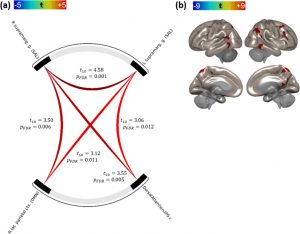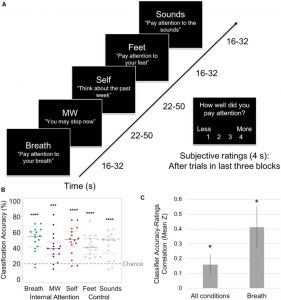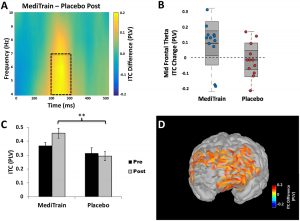Improve the Health and Well-Being of Patients with Functional Dyspepsia with Mindfulness
By John M. de Castro, Ph.D.
“mindfulness-based cognitive therapy reduces symptoms of functional dyspepsia and increases quality of life of the patients.” – Sobhan Pur Nik Dast
Functional Dyspepsia involves abdominal pain. Bloating, and nausea without a clear physical cause. It is often accompanied with anxiety. It is one of the most common digestive problems and affects 10% to 20% of the population. There is no cure. The symptoms are most frequently treated with over-the-counter medications such as antacids or anti-gas medications or even antidepressants. Stress is known to exacerbate dyspepsia. So, lifestyle changes are often recommended to reduce stress.
Mindfulness trainings have been shown to improve the physiological and psychological responses to stress and to reduce anxiety. They have also been shown to improve other digestive disorders such as irritable bowel syndrome (IBS). So, it is reasonable to investigate whether mindfulness training might be effective for functional dyspepsia. Dialectical Behavior Therapy (DBT) is a mindfulness-based therapy that focuses on changing the thoughts and emotions that precede problem behaviors, as well as by solving the problems faced by individuals that contribute to problematic thoughts, feelings and behaviors. In DBT five core skills are practiced; mindfulness, distress tolerance, emotion regulation, the middle path, and interpersonal effectiveness. It is not known if functional dyspepsia can be effectively treated with DBT.
In today’s Research News article “Comparison of dialectical behavior therapy and anti-anxiety medication on anxiety and digestive symptoms in patients with functional dyspepsia.” (See summary below or view the full text of the study at: https://www.ncbi.nlm.nih.gov/pmc/articles/PMC7554546/ ) Tavakoli and colleagues recruited adults diagnosed with functional dyspepsia and continued them on antacid medication (pantoprazole ) and randomly assigned them to one of three groups, receiving either 8 weekly 2.5 hour sessions of Dialectical Behavior Therapy (DBT), an antianxiety medication (sertraline), or no further treatment. They were measured before and after treatment for dyspepsia symptom severity and anxiety.
They found that after treatment the group that received Dialectical Behavior Therapy (DBT) had the greatest significant reduction is dyspepsia symptom severity with the anti-anxiety medication group second and no significant improvement in the no-treatment group. They also found that after treatment the group that received anti-anxiety medication had the greatest significant reduction is dyspepsia symptom severity with the DBT group second and no significant improvement in the no-treatment group.
These are interesting results that suggest that Dialectical Behavior Therapy (DBT) is effective for the treatment of the symptoms of functional dyspepsia including anxiety. But anti-anxiety medication is better at reducing anxiety levels. Since the mindfulness training of DBT does not require drugs with significant side effects, it would appear to be the preferred treatment for functional dyspepsia.
The mechanism by which DBT improves functional dyspepsia were not studied. Functional dyspepsia, however, is thought to be produced or exacerbated by stress. Mindfulness training is known to reduce the physiological and psychological responses to stress. So, it is likely that DBT reduces stress effects thereby improving functional dyspepsia.
So, improve the health and well-being of patients with functional dyspepsia with mindfulness.
“Meditation works at all levels to aid the digestive process, making it one of the most effective natural remedies for indigestion.” – Beeja
CMCS – Center for Mindfulness and Contemplative Studies
This and other Contemplative Studies posts are also available on Google+ https://plus.google.com/106784388191201299496/posts and on Twitter @MindfulResearch
Study Summary
Tavakoli, T., Hoseini, M., Tabatabaee, T., Rostami, Z., Mollaei, H., Bahrami, A., Ayati, S., & Bijari, B. (2020). Comparison of dialectical behavior therapy and anti-anxiety medication on anxiety and digestive symptoms in patients with functional dyspepsia. Journal of Research in Medical Sciences : The Official Journal of Isfahan University of Medical Sciences, 25, 59. https://doi.org/10.4103/jrms.JRMS_673_19
Abstract
Background:
Functional dyspepsia is a common chronic digestive disorder. The purpose of this study was to compare the effectiveness of dialectical behavior therapy and anti-anxiety medication in patients with functional dyspepsia.
Materials and Methods:
The present study was a randomized, controlled clinical trial with sixty patients who were suffering from functional dyspepsia that identified by the ROME III criteria. Patients were divided into three groups by using pre- and posttest design, including Group A (dialectal treatment and pantoprazole), Group B (anxiolytic drug treatment and pantoprazole), and Group C (no intervention, only pantoprazole were used). The Beck Anxiety Inventory and the patient assessment of Gastrointestinal Symptom Severity Index Questionnaire were completed by the patients after receiving the written consent. Finally, the data were analyzed using the Statistical Package for the Social Sciences software version 20.
Results:
There was a significant improvement in the severity of dyspepsia after intervention in all three groups. The greatest decrease in the severity of functional dyspepsia was observed in the dialectical behavioral therapy group as compared to the other groups (Group A: −15.4 ± 6.61, Group B: −3.85 ± 2.77, and Group C: −7.8 ± 4.02; P = 0.001). Furthermore, the Beck Anxiety Inventory scores were statistically significantly improved in all three groups (Group A: −5.75 ± 2.53, Group B: −7.3 ± 3.19, and Group C: −2.60 ± 1.5; P = 0.001). There was a positive correlation between the change in dyspepsia score and change in anxiety score across different intervention groups (r = 0.55; P < 0.001).
Conclusion:
Dialectical behavioral therapy can be effective in reducing anxiety and improving the dyspepsia symptoms in patients with functional dyspepsia compared to anti-anxiety medication or conventional therapy. Therefore, communication between the physicians and psychologists and psychiatrists can have positive effects on the treatment of these patients.
https://www.ncbi.nlm.nih.gov/pmc/articles/PMC7554546/









